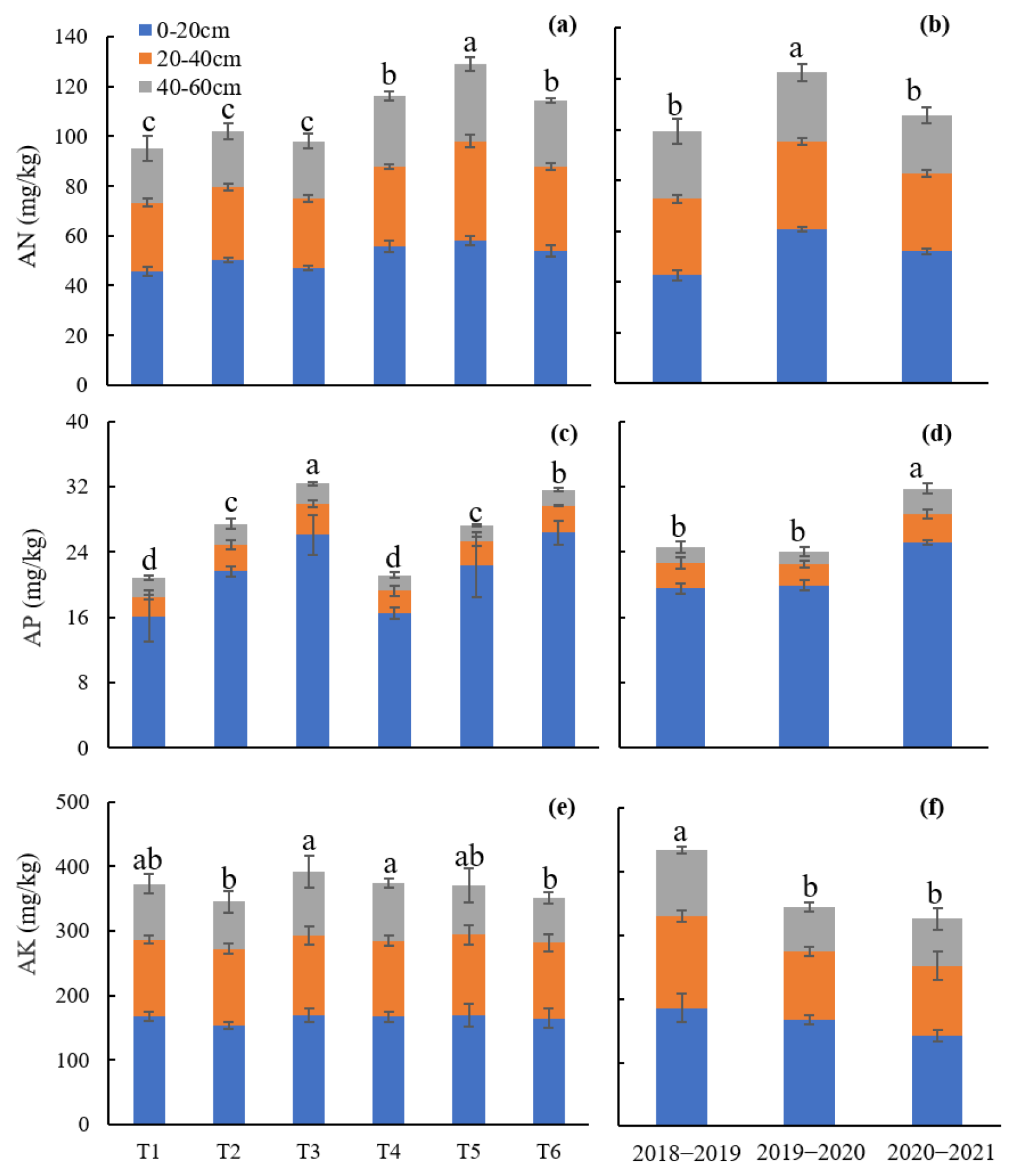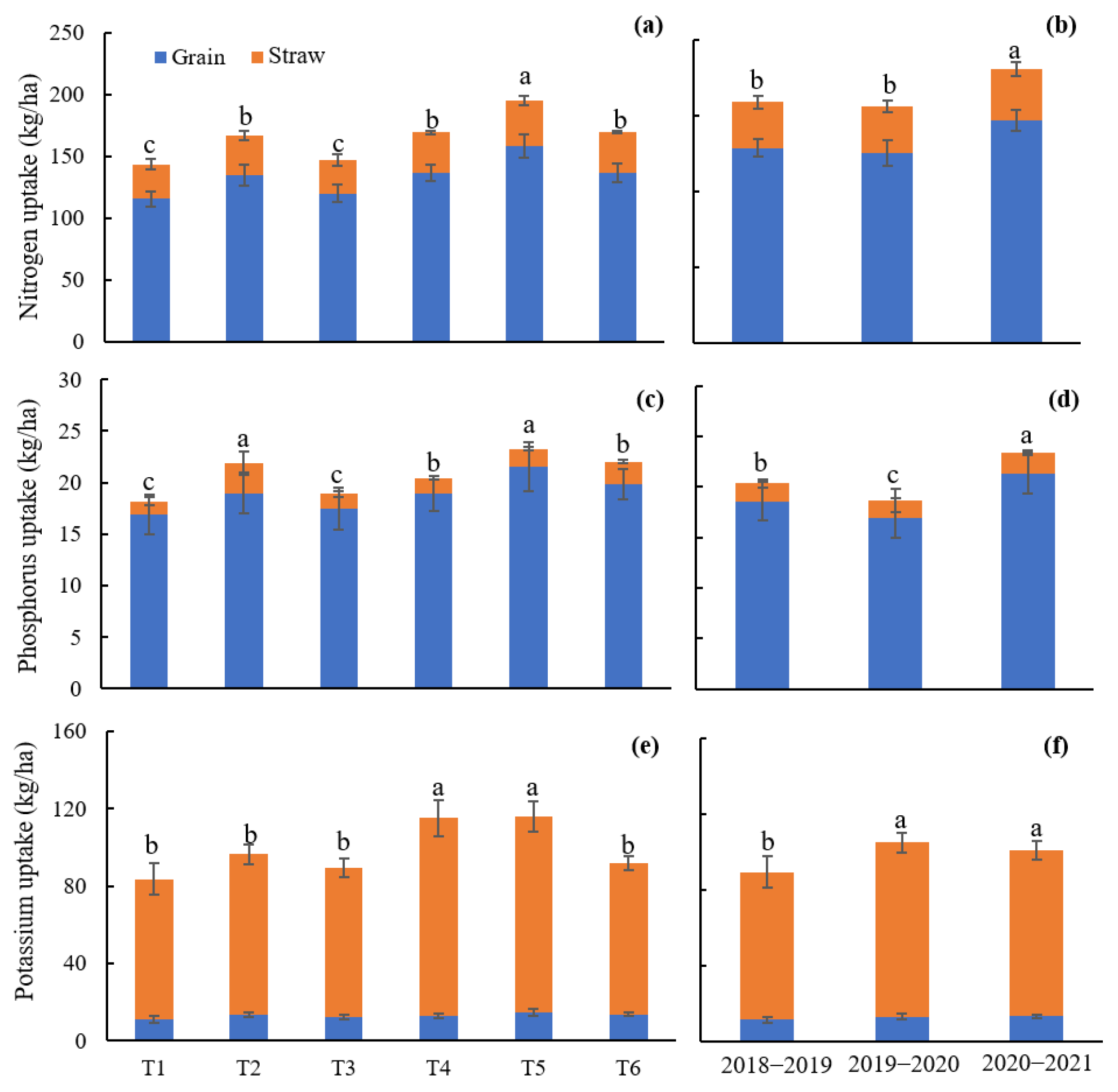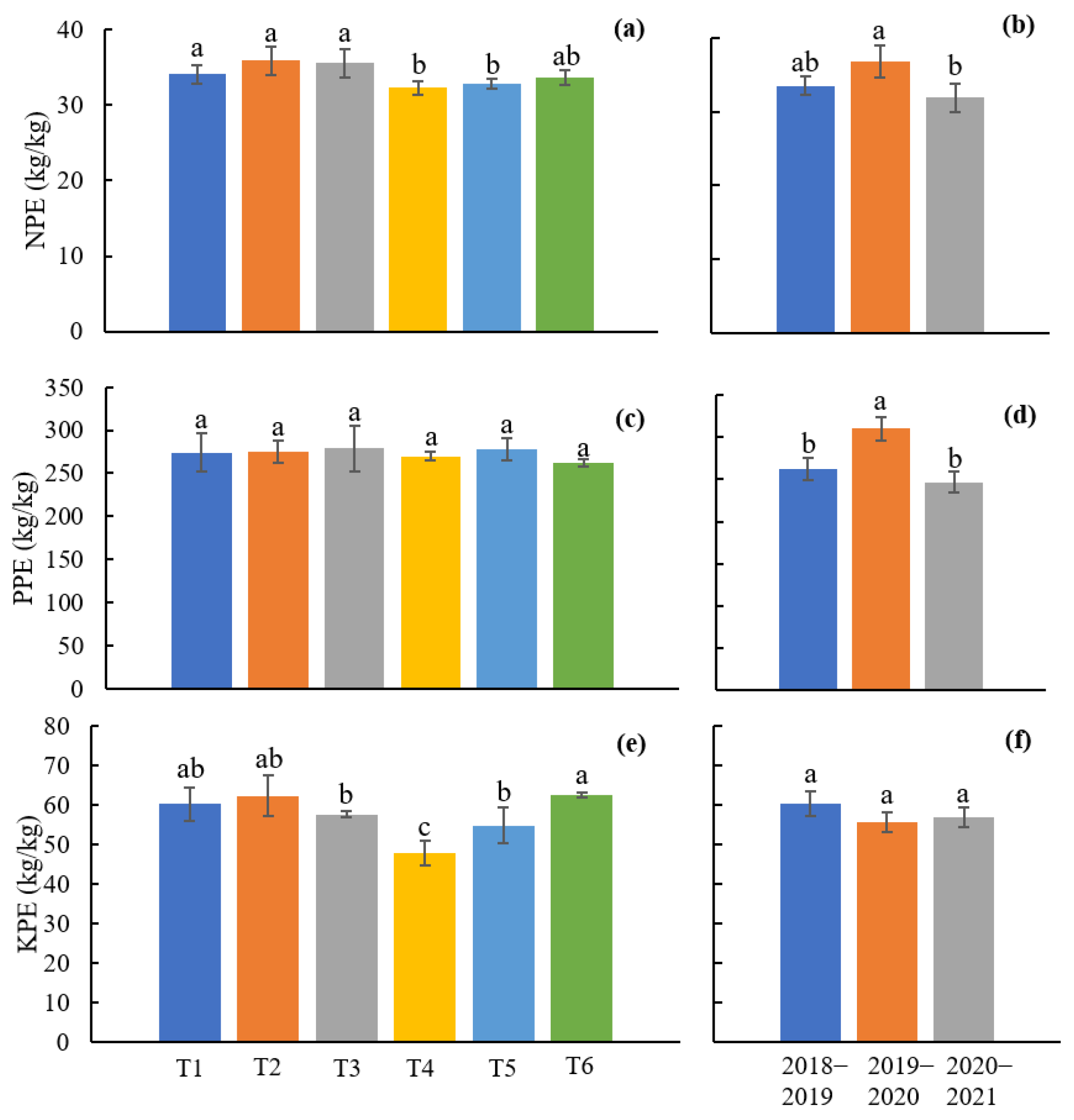Optimizing Nitrogen and Phosphorus Fertilizer Application for Wheat Yield on Alkali Soils: Mechanisms and Effects
Abstract
1. Introduction
2. Materials and Methods
2.1. Site and Experiments
2.2. Experimental Design
2.3. Data Analysis
2.4. Statistical Analysis
3. Results and Analysis
3.1. Effects of Fertilizer Application on Wheat Yield
3.2. Effects of Fertilizer Application on Wheat Biomass Yield and Thousand-Grain Weight
3.3. Effects of Fertilizer Application on Soil Nutrients
3.4. Effects of Fertilizer Application on Plant Nutrients
3.5. Effects of Fertilizer Application on Production Efficiency
3.6. Path Analysis of Factors Affecting Wheat Yield
4. Discussion
4.1. Optimal Nitrogen and Phosphorus Application Rates for Wheat Cultivation in Alkali Soils
4.2. Impact of Pathways of Fertilizer Application on Wheat Yield
5. Conclusions
Author Contributions
Funding
Data Availability Statement
Conflicts of Interest
References
- FAO. Global Report on Food Crises. 2022. Available online: https://www.fao.org/3/cb9997en/cb9997en (accessed on 4 May 2022).
- Liu, S.L.; Hou, X.Y.; Yang, M.; Cheng, F.Y.; Coxixo, A.; Wu, X.; Zhang, Y.Q. Factors driving the relationships between vegetation and soil properties in the Yellow River Delta, China. Catena 2018, 165, 279–285. [Google Scholar] [CrossRef]
- Xia, J.B.; Ren, J.Y.; Zhang, S.Y.; Wang, Y.H.; Fang, Y. Forest and grass composite patterns improve the soil quality in the coastal alkali land of the Yellow River Delta, China. Geoderma 2019, 349, 25–35. [Google Scholar] [CrossRef]
- Shrivastava, P.; Kumar, R. Soil salinity: A serious environmental issue and plant growth promoting bacteria as one of the tools for its alleviation. Saudi J. Biol. Sci. 2015, 22, 123–131. [Google Scholar] [CrossRef]
- Huang, M.Y.; Zhang, Z.Y.; Zhai, Y.M.; Lu, P.R.; Zhu, C.L. Effect of straw biochar on soil properties and wheat production under saline water irrigation. Agronomy 2019, 9, 457. [Google Scholar] [CrossRef]
- Huang, X.M.; Xu, X.P.; Zhu, Q.C.; Zhang, Y.T. Optimizing water and nitrogen inputs for sustainable wheat yields and minimal environmental impacts. Agric. Syst. 2024, 220, 104061. [Google Scholar] [CrossRef]
- Xie, H.; Li, J.; Zhang, Y.; Xu, X.; Wang, L.; Ouyang, Z. Evaluation of coastal farming under salinization and optimized fertilization strategies in China. Sci. Total Environ. 2021, 797, 149038. [Google Scholar] [CrossRef]
- Eynard, A.; Lal, R.; Wiebe, K. Crop Response in Salt-Affected Soils. J. Sustain. Agric. 2005, 27, 5–50. [Google Scholar] [CrossRef]
- Wang, X.; Shi, W.; Sun, X.; Wang, M. Comprehensive benefits evaluation and its spatial simulation for well-facilitated farmland projects in the Huang-Huai-Hai Region of China. Land Degrad. Dev. 2020, 31, 1837–1850. [Google Scholar] [CrossRef]
- Yan, S.; Wu, Y.; Fan, J.; Zhang, F.; Zheng, J.; Qiang, S.; Guo, J.; Xiang, Y.; Zou, H.; Wu, L. Dynamic change and accumulation of grain macronutrient (N, P and K) concentrations in winter wheat under different drip fertigation regimes. Field Crops Res. 2020, 250, 107767. [Google Scholar] [CrossRef]
- Zörb, C.; Ludewig, U.; Hawkesford, M.J. Perspective on Wheat Yield and Quality with Reduced Nitrogen Supply. Trends Plant Sci. 2018, 23, 1029–1037. [Google Scholar] [CrossRef]
- Wang, Y.J.; Wang, D.M.; Tao, Z.Q.; Yang, Y.S.; Gao, Z.X.; Zhao, G.C.; Chang, X.H. Impacts of Nitrogen Deficiency on Wheat (Triticum aestivum L.) Grain During the Medium Filling Stage: Transcriptomic and Metabolomic Comparisons. Front. Plant Sci. 2021, 12, 674433. [Google Scholar] [CrossRef] [PubMed]
- Song, X.; Zhou, G.; Ma, B.L.; Wu, W.; Ahmad, I.; Zhu, G.; Yan, W.; Jiao, X. Nitrogen application improved photosynthetic productivity, chlorophyll fluorescence, yield and yield components of two oat genotypes under saline conditions. Agronomy 2019, 9, 115. [Google Scholar] [CrossRef]
- Johan, P.D.; Ahmed, O.h.; Omar, L.; Hasbullah, N.A. Phosphorus Transformation in Soils Following Co-Application of Charcoal and Wood Ash. Agronomy 2021, 11, 2010. [Google Scholar] [CrossRef]
- Ma, C.J.; Yuan, H.; Shi, N.; Sun, Z.; Liu, S.; Wang, X.; Li, B.; Li, S.; Liu, Z. Effects of phosphate application rate on grain yield and nutrition use of summer maize under the Coastal Alkali Land. Agronomy 2023, 13, 2668. [Google Scholar] [CrossRef]
- Shen, Q.; Wen, Z.H.; Dong, Y.; Li, H.G.; Miao, Y.X.; Shen, J.B. The responses of root morphology and phosphorus-mobilizing exudations in wheat to increasing shoot phosphorus concentration. AoB Plants 2018, 10, ply054. [Google Scholar] [CrossRef]
- Chen, X.; Yan, X.; Wang, M.; Cai, Y.; Weng, X.; Su, D.; Guo, J.; Wang, W.; Hou, Y.; Ye, D. Long-term excessive phosphorus fertilization alters soil phosphorus fractions in the acidic soil of pomelo orchards. Soil. Tillage Res. 2022, 215, 105214. [Google Scholar] [CrossRef]
- Kim, G.W.; Lim, J.Y.; Islam-Bhuiyan, M.S.; Das, S.; Khan, M.I.; Kim, P.J. Investigating the arable land that is the main contributor to global warming between paddy and upland vegetable crops under excessive nitrogen fertilization. J. Clean. Prod. 2022, 346, 131197. [Google Scholar] [CrossRef]
- Wang, H.; Ren, H.; Han, K.; He, Q.; Zhang, L.; Zhao, Y.; Liu, Y.; Zhang, J.; Zhao, B.; Ren, B. Sustainable improvement strategies for summer maize yield, nitrogen use efficiency and greenhouse gas emission intensity in the North China Plain. Eur. J. Agron. 2023, 143, 126712. [Google Scholar] [CrossRef]
- Walkley, A.; Black, I.A. An Examination of the Degtjareff Method for Determining Soil Organic Matter and a Proposed Modification of the Chromic Acid Titration Method. Soil. Sci. 1934, 37, 29–38. [Google Scholar] [CrossRef]
- Chen, B.L.; Yang, H.K.; Song, W.C.; Liu, C.Y.; Wu, J.; Zhao, W.Q.; Zhou, Z.G. Effect of N fertilization rate on soil alkali-hydrolyzable N, subtending leaf N concentration, fiber yield, and quality of cotton. Crop J. 2016, 4, 323–330. [Google Scholar] [CrossRef]
- Ma, C.J.; Wu, W.B.; Hou, P.; Wang, Y.; Li, B.W.; Yuan, H.B.; Liu, L.N.; Wang, X.J.; Sun, Z.Q.; Li, Y. Effect of combined nitrogen and phosphorus fertilization on summer maize yield and soil fertility in coastal alkali land. Agric. Water Manag. 2025, 309, 109277. [Google Scholar] [CrossRef]
- Mu, X.H.; Chen, Q.W.; Chen, F.J.; Yuan, L.X.; Mi, G.H. Within-lea nitrogen allocation in adaptation to low nitrogen supply in maize during grain-filling stage. Front. Plant Sci. 2016, 7, 699. [Google Scholar] [CrossRef] [PubMed]
- Zhang, Y.; Wei, W.; Gao, W.; Cui, H.; Xu, X.; Jiang, W.; Liu, S. Content patterns of maize endogenous hormones and grain yield influenced by field phosphorus application. Agronomy 2023, 13, 1911. [Google Scholar] [CrossRef]
- Zhang, Z.B.; Jia, C.L.; Ren, B.Z.; Liu, P.; Zhao, B.; Zhang, J.W. Effects of combined application of nitrogen and phosphorus on yield and leaf senescence physiological characteristics in summer maize. Acta Agron. Sin. 2023, 49, 1616–1629. [Google Scholar]
- Hussain, M.Z.; Hamilton, S.K.; Robertson, G.P.; Basso, B. Phosphorus availability and leaching losses in annual and perennial cropping systems in an upper US Midwest landscape. Sci. Rep. 2021, 11, 20367. [Google Scholar] [CrossRef]
- Cecilia, C.I.; Fabrizio, D.I.A.; Rosa, G.A. Phosphorus downward movement in soil highly charged with cattle manure. Environ. Earth Sci. 2016, 75, 5687. [Google Scholar] [CrossRef]
- Luo, X.; Mazer, S.J.; Guo, H.; Zhang, N.; Weiner, J.; Hu, S. Nitrogen: Phosphorous supply ratio and allometry in five alpine plant species. Ecol. Evol. 2016, 6, 8881–8892. [Google Scholar] [CrossRef]
- Plaza-Bonilla, D.; Lampurlanes, J.; Fernandez, F.G.; Cantero-Martinez, C. Nitrogen fertilization strategies for improved Mediterranean rainfed wheat and barley performance and water and nitrogen use efficiency. Eur. J. Agron. 2021, 124, 126238. [Google Scholar] [CrossRef]
- Shi, Z.; Liu, D.; Liu, M.; Hafeez, M.B.; Wen, P.; Wang, X.; Wang, R.; Zhang, X.; Li, J. Optimized fertilizer recommendation method for nitrate residue control in a wheat–maize double cropping system in dryland farming. Field Crops Res. 2021, 271, 108258. [Google Scholar] [CrossRef]
- Li, Y.H.; Zhou, B.B.; Ren, P.Q.; Shan, Y.Y.; Xue, W.Q. Effects of water and fertilizer regulation modes on water fertilizer and utilization efficiency of spring maize in coastal saline–alkali land. J. Irrig. Drain. Eng. 2023, 41, 80–88. [Google Scholar] [CrossRef]
- Dai, J.; Wang, Z.; Li, M.; He, G.; Li, Q.; Cao, H.; Wang, S.; Gao, Y.; Hui, X. Winter wheat grain yield and summer nitrate leaching: Long-term effects of nitrogen and phosphorus rates on the Loess Plateau of China. J. Field Crops Res. 2016, 196, 180–190. [Google Scholar] [CrossRef]
- Wen, Z.; Shen, J.; Blackwell, M.; Li, H.; Zhao, B.; Yuan, H. Combined applications of nitrogen and phosphorus fertilizers with manure increase maize yield and nutrient uptake via stimulating root growth in a long-term experiment. Pedosphere 2016, 26, 62–73. [Google Scholar] [CrossRef]
- Khan, A.; Lu, G.; Ayaz, M.; Zhang, H.; Wang, R.; Lv, F.; Yang, X.; Sun, B.; Zhang, S. Phosphorus efficiency, soil phosphorus dynamics and critical phosphorus level under long-term fertilization for single and double cropping systems. Agr Ecosyst. Environ. 2018, 256, 1–11. [Google Scholar] [CrossRef]
- Galindo, F.S.; Strock, J.S.; Pagliari, P.H. Nutrient accumulation affected by corn stover management associated with nitrogen and phosphorus fertilization. Agriculture 2021, 11, 1118. [Google Scholar] [CrossRef]
- Schlegel, A.J.; Havlin, J.L. Corn yield and grain nutrient uptake from 50 years of nitrogen and phosphorus fertilization. Agron. J. 2017, 109, 335–342. [Google Scholar] [CrossRef]







| Soil Depth (cm) | Conductivity (mS cm−1) | pH | Organic Matter (g kg−1) | Alkaline Hydrolyzable Nitrogen (mg kg−1) | Available Phosphorus (mg kg−1) | Available Potassium (mg kg−1) |
|---|---|---|---|---|---|---|
| 0–20 | 0.21 | 8.16 | 9.63 | 50.72 | 10.36 | 152 |
| 20–40 | 0.47 | 8.07 | 6.83 | 56.17 | 5.96 | 122 |
| 40–60 | 0.59 | 8.01 | 3.68 | 23.29 | 5.79 | 59 |
| GNU | GPU | GKU | SNU | SPU | SKU | |
|---|---|---|---|---|---|---|
| Treatment | 8.76 ** | 10.32 ** | 11.69 ** | 2.12 * | 0.73 ns | 1.72 * |
| Year | 74.57 ** | 56.97 ** | 74.46 ** | 6.14 ** | 10.98 ** | 19.71 ** |
| Treatment × year | 2.18 *ns | 1.73 ns | 2.23 * | 1.97 ns | 0.90 ns | 3.14 ** |
Disclaimer/Publisher’s Note: The statements, opinions and data contained in all publications are solely those of the individual author(s) and contributor(s) and not of MDPI and/or the editor(s). MDPI and/or the editor(s) disclaim responsibility for any injury to people or property resulting from any ideas, methods, instructions or products referred to in the content. |
© 2025 by the authors. Licensee MDPI, Basel, Switzerland. This article is an open access article distributed under the terms and conditions of the Creative Commons Attribution (CC BY) license (https://creativecommons.org/licenses/by/4.0/).
Share and Cite
Hou, P.; Li, B.; Cao, E.; Liu, Z.; Li, Y.; Sun, Z.; Xiao, Y.; Ma, C. Optimizing Nitrogen and Phosphorus Fertilizer Application for Wheat Yield on Alkali Soils: Mechanisms and Effects. Agronomy 2025, 15, 734. https://doi.org/10.3390/agronomy15030734
Hou P, Li B, Cao E, Liu Z, Li Y, Sun Z, Xiao Y, Ma C. Optimizing Nitrogen and Phosphorus Fertilizer Application for Wheat Yield on Alkali Soils: Mechanisms and Effects. Agronomy. 2025; 15(3):734. https://doi.org/10.3390/agronomy15030734
Chicago/Turabian StyleHou, Peng, Bowen Li, Enkai Cao, Zhaohui Liu, Yan Li, Zeqiang Sun, Yang Xiao, and Changjian Ma. 2025. "Optimizing Nitrogen and Phosphorus Fertilizer Application for Wheat Yield on Alkali Soils: Mechanisms and Effects" Agronomy 15, no. 3: 734. https://doi.org/10.3390/agronomy15030734
APA StyleHou, P., Li, B., Cao, E., Liu, Z., Li, Y., Sun, Z., Xiao, Y., & Ma, C. (2025). Optimizing Nitrogen and Phosphorus Fertilizer Application for Wheat Yield on Alkali Soils: Mechanisms and Effects. Agronomy, 15(3), 734. https://doi.org/10.3390/agronomy15030734





